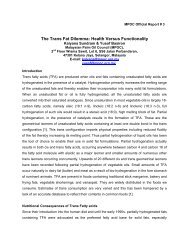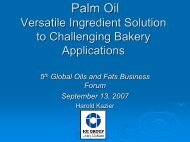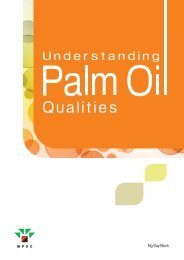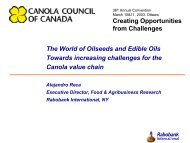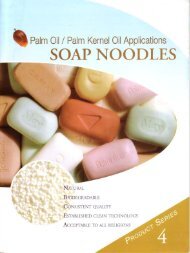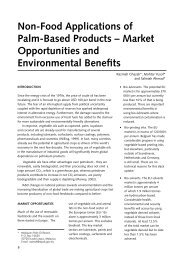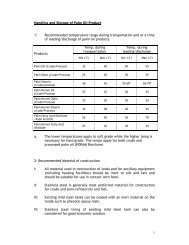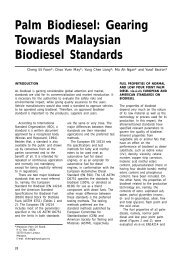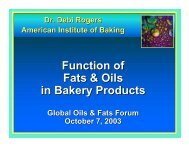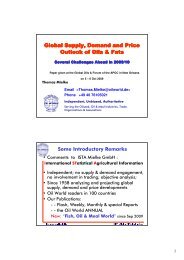Create successful ePaper yourself
Turn your PDF publications into a flip-book with our unique Google optimized e-Paper software.
Bacteria need food for energy and growth, and thrive oncertain types of food. Potentially hazardous foods arethose high in protein such as meat, poultry, fish andshellfish. Dairy products, eggs, grains and somevegetables are also sufficiently high in protein tosupport bacterial growth. These foods anditems containing these foods (for example,custard, hollandaise sauce and quiche)must be handled with great care.Food spoilage is linked to one or more of thesecauses:- Inappropriate storage temperature, like exposure to extremetemperatures- Incorrect or excessive period of storage- Unacceptable levels of ventilation in storage areas- Failure to separate items being stored- Excessive delays between receipt and storage of products- Inadequate or unacceptable sanitation standards- Physical changes, such as excessive pressure or carelesshandling that causes bruisingFoods are frequently classified on the basis of ‘stability’, whichrefers to susceptibility to microbial spoilage. Generally food isclassified into three broad categories.Non-perishableThese foods are the most resistant to spoilage unless improperlyhandled and stored.They mainly comprise dry grocery items likesugar, salt and spices.Semi-perishableFoods spoil more slowly when stored under recommended timetemperaturecombinations.They include baked goods, hard cheeses,dried fruits and vegetables, and waxed vegetables such as cucumber.PerishableSuch foods spoil readily without special processing orpreservation techniques. This category includes meats, poultry,fish, shellfish, eggs, dairy products, most fruits and vegetables, andall cooked items.Bacteria controlThree basic principles help protect food against bacteria.- Protect foodfrom bacteria in air.- Practise proper hygiene.- Clean utensils properly.Avoid conditions that promote growth of bacteria.If bacteria are present, kill them by subjecting the food to ahigh temperature (77°C) for at least 5 minutes.Temperature is the most important and most easily controlledfactor. Most micro-organisms are destroyed at hightemperatures. Freezing slows but does not stop bacterialgrowth, or destroy bacteria.Most of the bacteria that cause food-borne illnesses multiplyrapidly at temperatures from 16-49°C.Therefore, the broad rangefrom 4-60ºC is deemed the temperature danger zone.To controlthe growth of any bacteria present, it is important to maintain theinternal temperature of food at 60ºC or above, or 4ºC or below.Keep cold foods coldFoods that are to be displayed, stored or served cold must becooled rapidly. When cooling foods:- Refrigerate semi-solid foods at 4ºC or below in containers thatare less than 5cm deep (increased surface area decreasescooling time).- Avoid crowding the refrigerator; allow air to circulate around foods;- Use pre-chilled ingredients, for example, mayonnaise, toprepare cold foods.- Store cooked foods above raw foods to preventcross-contamination.Keep bacteria from spreading:- Don’t touch contaminated foods.GLOBAL OILS & FATS BUSINESS MAGAZINE • VOL.5 ISSUE 1, 200829



